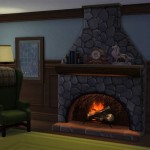River Rock Fireplace Painted White: A Transformation Guide
River rock fireplaces offer a rustic, textured aesthetic that can be a stunning focal point in a home. However, these fireplaces, particularly older ones, may not always align with current design trends. Painting a river rock fireplace white can dramatically transform its appearance, creating a brighter, more contemporary look while retaining the unique texture of the stone. This article provides a comprehensive guide to understanding the process, considerations, and best practices for painting a river rock fireplace white.
Before embarking on this project, it’s crucial to assess the existing fireplace and the desired outcome. Factors such as the type of river rock, the existing finish (if any), and the overall architectural style of the room will influence the choice of paint, primer, and application techniques. A well-planned approach will ensure a successful and aesthetically pleasing transformation.
Key Considerations Before Painting
Several critical factors must be considered before commencing the painting process. These considerations directly impact the final outcome and the longevity of the paint job.
Rock Type and Porosity: River rocks vary significantly in their composition and porosity. Some rocks are smooth and relatively non-porous, while others are rougher and more absorbent. Porous rocks will require more primer and paint to achieve adequate coverage and adhesion. Identifying the predominant rock type will help determine the appropriate products and application techniques. For example, rocks with a high degree of porosity may benefit from multiple coats of primer to seal the surface effectively.
Existing Finish and Condition: The presence of an existing finish, whether it's a sealant, stain, or previous paint, needs to be addressed. Any loose or flaking material must be removed to provide a sound surface for the new paint to adhere to. The condition of the grout between the rocks is also important. Crumbling or damaged grout should be repaired before painting to prevent moisture from seeping behind the rocks, which can lead to paint failure. Cleaning the existing rocks is important. Depending on the condition of the rocks, pressure washing might also be a good choice.
Heat Resistance: Fireplaces generate significant heat, particularly around the firebox. It is essential to select paints and primers specifically designed for high-temperature environments. Using standard interior paints near the firebox could result in blistering, peeling, and discoloration, as well as the release of harmful fumes. High-heat paints are formulated to withstand these extreme temperatures and maintain their integrity.
Color and Sheen: While the goal is a white fireplace, nuances in color and sheen can significantly affect the overall aesthetic. Different shades of white, from bright white to off-white, can create varying levels of warmth and contrast within the room. The sheen, ranging from matte to gloss, will influence the light reflectivity and the perceived texture of the rocks. A matte or eggshell finish is generally preferred for river rock fireplaces as it minimizes glare and enhances the natural texture of the stone. Consider how the chosen white will complement the trim color in the room. In some cases, you may wish to paint the trim as well.
Materials and Tools Required
A successful river rock fireplace painting project requires the right materials and tools. Investing in high-quality products will ensure a professional-looking finish that lasts.
Cleaning Supplies: A thorough cleaning is paramount. This includes: Stiff-bristled brushes (wire brushes for stubborn areas), a pressure washer (optional, for heavily soiled fireplaces), TSP (trisodium phosphate) or a similar degreasing cleaner, buckets, sponges, and clean cloths.
Painter's Tape and Drop Cloths: Protecting the surrounding area is crucial. High-quality painter's tape will create clean lines and prevent paint from bleeding onto adjacent surfaces. Drop cloths will protect floors and furniture from spills and splatters. Plastic sheeting can also be used to cover larger areas.
Primer: A high-quality masonry primer is essential for sealing the porous surface of the river rocks and providing a good base for the paint to adhere to. Choose a primer specifically designed for masonry or stone surfaces. Consider a stain-blocking primer if there are existing stains on the rocks.
Paint: Select a high-heat paint designed for fireplaces, particularly around the firebox. For the remaining areas, a high-quality acrylic latex paint formulated for interior use is suitable. Ensure the paint is compatible with the chosen primer. Oil based paints tend to yellow over time, so using a quality acrylic latex paint is usually the best choice.
Brushes and Rollers: A variety of brushes and rollers will be needed to effectively apply the primer and paint to the uneven surface of the river rocks. Angled brushes are ideal for getting into crevices and corners, while foam rollers can provide a smooth, even finish on larger, flatter areas. Consider using a textured roller to enhance the natural texture of the rocks. Small brushes are also recommended for detail work.
Safety Gear: Safety should be a priority. Wear safety glasses to protect your eyes from splashes and debris, and a respirator mask to avoid inhaling paint fumes. Gloves will protect your hands from paint and cleaning solutions.
Step-by-Step Painting Process
Following a systematic approach will ensure a professional and durable finish. This section outlines the key steps involved in painting a river rock fireplace white.
Preparation: Begin by thoroughly cleaning the fireplace. Use a stiff-bristled brush and TSP solution to remove dirt, dust, soot, and any loose debris. Rinse the fireplace thoroughly with clean water and allow it to dry completely. If the fireplace is heavily soiled, consider using a pressure washer to remove ingrained dirt and grime. Repair any damaged grout with a suitable masonry repair compound. Allow the repair compound to cure completely before proceeding.
Taping and Protecting: Use painter's tape to mask off any areas that you do not want to paint, such as the firebox opening, mantel, and surrounding walls. Cover the floor and any nearby furniture with drop cloths or plastic sheeting to protect them from paint splatters.
Priming: Apply a generous coat of masonry primer to the entire fireplace surface. Use a combination of brushes and rollers to ensure that all surfaces, including crevices and corners, are fully coated. Allow the primer to dry completely according to the manufacturer's instructions. Depending on the porosity of the rocks, a second coat of primer may be necessary to achieve adequate sealing. The purpose of the primer is to block potential stains from the existing rocks, and also to help the paint adhere well. Without primer, the paint is more likely to chip or peel off. Also, unsealed rock is very porous, and may require many coats of paint to achieve suitable coverage.
Painting: Once the primer is completely dry, begin applying the first coat of paint. Use the same combination of brushes and rollers as you did for the primer, ensuring that all surfaces are evenly coated. Pay particular attention to getting into the crevices and corners between the rocks. Allow the first coat of paint to dry completely according to the manufacturer's instructions. Apply a second coat of paint to achieve full coverage and a uniform finish. Depending on the paint's opacity and the desired look, a third coat may be necessary. Painting in thin coats is the best practice to avoid drips and runs.
Detailing and Touch-Ups: Once the final coat of paint is dry, carefully remove the painter's tape. Inspect the fireplace for any imperfections or areas that need touch-ups. Use a small brush to carefully touch up any blemishes or missed spots. Allow the touch-up paint to dry completely.
Curing: Allow the paint to cure completely before using the fireplace. Curing typically takes several days, during which time the paint hardens and becomes more durable.
Post-Painting Considerations: Once the paint is 100% dry, use a clear sealant to protect the newly painted river rocks from stains and moisture. A sealant specifically designed for this application will make the paint last longer. Additionally, cleaning the fireplace on a regular basis will prevent build up of soot and grime which will help maintain the beauty of your newly painted fireplace.

Farmhouse Family Room With Painted White Fireplace River Rock Tall Fir Fireplaces Home Farm House Living

Diy River Rock Fireplace Painted White Fireplaces Stone Makeover

Stone Fireplace Ideas For Cozy Comfort In The Home Town Country Living

Painted White Rock Fireplace Before And After Google Search Fireplaces Stone Makeover

Before And After Ave F House Redondo Beach Stone Fireplace Makeover Painted Rock Fireplaces

Stone Fireplace Makeover Part 2 Faux Whitewash Organized Ish

How To German Smear A Dated River Rock Fireplace Krista Gilbert

How To Paint River Rock For An Updated Look

Painted Rock Fireplaces Fireplace Remodel

Kylie M Interiors How To Update Your Fireplace 5 Easy Ideas
Related Posts








